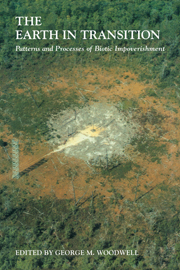Book contents
- Frontmatter
- Contents
- Preface
- Acknowledgments
- List of Contributors
- Part I Global Change and the Patterns of Impoverishment
- 1 The Earth under Stress: A Transition to Climatic Instability Raises Questions about Patterns of Impoverishment
- 2 The Experimental Impoverishment of Natural Communities: Effects of Ionizing Radiation on Plant Communities, 1961 – 1976
- 3 Air Pollution and Temperate Forests: Creeping Degradation
- 4 The Long-Term Effects of Air Pollutants on Lichen Communities in Europe and North America
- 5 Biotic Impoverishment in Northern Peatlands
- 6 Climatic Change and the Survival of Forest Species
- 7 The Atmosphere and the Future of the Biosphere: Points of Interactive Disturbance
- Part II Chronic Disturbance and Natural Ecosystems: Forests
- Part III Chronic Disturbance and Natural Ecosystems: Woodlands, Grasslands, and Tundra
- Part IV Chronic Disturbance and Natural Ecosystems: Aquatic and Emergent Ecosystems
- Part V Conclusion: Steps toward a World That Runs Itself
- Name Index
- Subject Index
1 - The Earth under Stress: A Transition to Climatic Instability Raises Questions about Patterns of Impoverishment
Published online by Cambridge University Press: 24 November 2009
- Frontmatter
- Contents
- Preface
- Acknowledgments
- List of Contributors
- Part I Global Change and the Patterns of Impoverishment
- 1 The Earth under Stress: A Transition to Climatic Instability Raises Questions about Patterns of Impoverishment
- 2 The Experimental Impoverishment of Natural Communities: Effects of Ionizing Radiation on Plant Communities, 1961 – 1976
- 3 Air Pollution and Temperate Forests: Creeping Degradation
- 4 The Long-Term Effects of Air Pollutants on Lichen Communities in Europe and North America
- 5 Biotic Impoverishment in Northern Peatlands
- 6 Climatic Change and the Survival of Forest Species
- 7 The Atmosphere and the Future of the Biosphere: Points of Interactive Disturbance
- Part II Chronic Disturbance and Natural Ecosystems: Forests
- Part III Chronic Disturbance and Natural Ecosystems: Woodlands, Grasslands, and Tundra
- Part IV Chronic Disturbance and Natural Ecosystems: Aquatic and Emergent Ecosystems
- Part V Conclusion: Steps toward a World That Runs Itself
- Name Index
- Subject Index
Summary
Life occurs, as far as we know, only as part of the earthly biosphere. There is no life elsewhere in the solar system, and if there is life beyond it on one of the tens of billions of planets of the universe, it is not likely to be of more than momentary academic interest in a world preoccupied with human crises.
Life exists at once as diverse entities, individuals, populations, and species, apparently independent, yet dependent for survival itself on a web of interconnections with other species immediately available – a community. And, in a context only slightly larger, dependent for place and time and habitat on the totality of other life that sustains the biosphere. Could we imagine a forest without decay? Or a ruminant without its cellulose-digesting flora?
The annual fluctuation in the carbon dioxide concentration in the atmosphere offers one of the most impressive bits of evidence of the importance of the biota in maintaining a habitat suitable for humans. Each year during the spring and summer the carbon dioxide concentration of the air of the northern hemisphere is reduced by several parts per million as forests of the temperate zone store carbon compounds through photosynthesis. Each year the carbon dioxide content rises through the fall and winter as respiration of forests and soils exceeds photosynthesis.
- Type
- Chapter
- Information
- The Earth in TransitionPatterns and Processes of Biotic Impoverishment, pp. 3 - 8Publisher: Cambridge University PressPrint publication year: 1991
- 1
- Cited by



